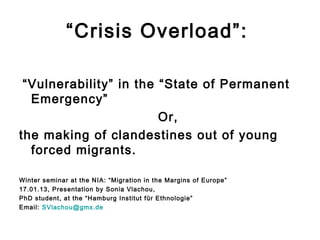
Crisis overload
- 1. “Crisis Overload”: “Vulnerability” in the “State of Permanent Emergency” Or, the making of clandestines out of young forced migrants. Winter seminar at the NIA: “Migration in the Margins of Europe” 17.01.13, Presentation by Sonia Vlachou, PhD student, at the “Hamburg Institut für Ethnologie” Email: SVlachou@gmx.de
- 2. 1. Aims and contour: Focus group/ Research duration/ Location/ Ages “Childhood” and “Youth” as • Livelihood Capital • Manifestations of the biopolitical border. Symbolic, legal, factual facets to explore.
- 3. 2. Time horizon of the research 2. a . Integration of the issue to a 2.b. New migration contemporary era realities in the South according to legal of Europe since 2000 developments: From a “European and • 2003, the “Dublin II global South to the regulation” EU North”- scheme • 2005, the adoption of To a the UN “Guiding “global South moving Instructions for Asylum- to the EU South” Applicant Children -scheme Migrants”.
- 4. 3. West, sub-Saharan African migrants in Greece: • 3. a. Constant push factors out of Sub-Saharan West Africa. • 3. b. The tracing of new routes into the European continent.
- 5. First the maritime, and later on the land border between Greece and Turkey.
- 6. 4. Conceptualizing Childhood and Youth within a migratory framework: Both categories pending in socio-cultural transitivity. • 4. a. The overlap of “Migrant” and “Child” = vulnerability maximized. • 4. b. Forced Children Migrants as a social scientific category connected to states of ‘RUINED VITAL SPACE”.
- 7. 4. c. Possible Administrative/ Bureaucratic cases of Independent Children Migrants: • The “Invisibles” • Those re-invented from authorities: • Self- reinvented ones • Non- asylum applicant Independent child Migrants • Those attempting family re-unification in the rest of EU • Consciously asylum applicant minors • “No- clues”.
- 8. 5. Unaccompanied Minors as asylum applicant children migrants: 5. a. Legal definition (PD 220/2007, article 1, point 6) …any individual that is a citizen of a third country of non-Greek nationals, under 18 years of age, who arrives separated from his parents and who is not taken care of by any adult guardian, responsible to do so. An underage person is considered to be an “Unaccompanied Minor” for as long as he is not placed under the legal guardianship after his/ her entering Greece ( Dimitropoulou, Papageorgiou 2008, UNHCR) .
- 9. 5. b. The detention and reception of Children Migrants. First, detention with adults, Then, homelessness, or reception centers for minors (12 structures housing minors all over GR).
- 10. 6. Margins of Agency 6. a. “Youthency”: • The self-conscious re-infantilization as a • life strategy, as catalytic piece of Agency to overcome the biopolitical border. • A “human rights equalizer”. • a time of suspension from reaching the state of living of a Bogus Migrant.
- 11. 7. Institutions Implications of their classification under vulnerability status: Re-infantilization process that converts them to “institutional children”.
- 12. 7. a. The spatial semiology of existing centers 7. b. Aspects of institutional protection deficiency: • Unpreparedness to educate analphabetic, people with limited educational experience. • Lack of design to educational needs of mixed origins, (languages) • Absence of qualified staff • Funds scarcity + unclear arrangements • Exclusion from apprenticeship workshops • Exclusion from the schooling system
- 13. 7. b. Aspects of institutional protection deficiency (continue): • Essentializing social –educational deficit. • Re-constructing the Undeserving poor out of the “Vulnerable Children”. Outcome: The essentializing, normative view on alterity invalidates in fact the legal protection framework.
- 14. 8. “Durable solutions” (?) • 8. a. The lack of a transition plan for a sustainable adulthood. • 8. b. Systematic breaches of duty of the Greek police in renewing “pink cards”. • 8. c. The instrumentalization of the “Crisis Apparatus” as an exclusion mechanism based on nationality and race.
- 15. 9. Conclusion: An inglorious end for vulnerabilities Maximizing transitivity = maximizing vulnerability by driving Young forced migrants into clandestine, illicit, precarious labour. Who does really profit from this systematic, massive waste on human resources?